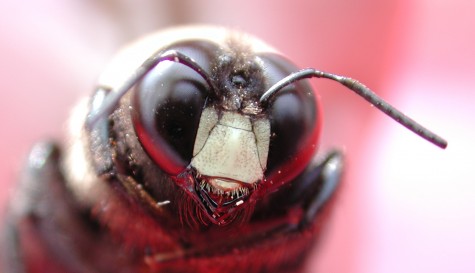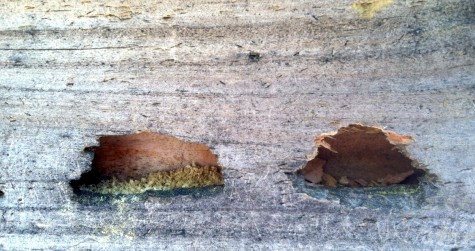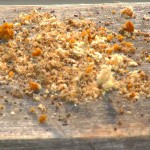 According to ancient historians, Archimedes spent the last moments of his life drawing figures in the dirt, so deeply entranced with the pleasures of geometry that he failed to notice the bloody pillage of Syracuse right outside his door. Aloofness, it’s tempting to conjecture, was his fatal flaw. By many accounts, he paid scant attention when a Roman soldier barged in and demanded that the old, prolific genius identify himself. Archimedes didn’t state his name or plea for his life. Instead, he responded with some version of, “Please, don’t disturb my circles.” At which point the Roman soldier ran him through with a sword. (Valerius Maximus adds a dramatic flourish to his account of those last seconds: “… and with his blood he confused the lines of his art.”)
According to ancient historians, Archimedes spent the last moments of his life drawing figures in the dirt, so deeply entranced with the pleasures of geometry that he failed to notice the bloody pillage of Syracuse right outside his door. Aloofness, it’s tempting to conjecture, was his fatal flaw. By many accounts, he paid scant attention when a Roman soldier barged in and demanded that the old, prolific genius identify himself. Archimedes didn’t state his name or plea for his life. Instead, he responded with some version of, “Please, don’t disturb my circles.” At which point the Roman soldier ran him through with a sword. (Valerius Maximus adds a dramatic flourish to his account of those last seconds: “… and with his blood he confused the lines of his art.”)
So ended Archimedes.
I can’t help but see Archimedes’ ghost—his circles, his aloofness—in a violent, natural drama that plays out every year in my backyard. (Anthropomorphism should probably be reserved for children’s books and special occasions. I claim the latter in this case.)
The drama begins with the return of the carpenter bees. These slow and steady creatures resemble obese bumblebees with bulbous, shiny abdomens. They’re big and big-eyed, and they can do something almost no
human can do without tools: Make a perfect circle.
They appear every spring, usually in March. First a few intrepid wanderers, then their friends, then grists upon grists, lounging around the wooden fence like rural teens orbiting picnic tables at a state fair. They’re slow and sure; they laze effortlessly. They hover like husky hummingbirds — often at eye-level, as if challenging their human underlings to a staring contest. (And in a staring contest, the organism that lacks eyelids always wins.) But they bluff: Males, the ones with telltale white faces, don’t have stingers. Females only sting when they’re provoked.
Carpenter bees—I’m most likely describing Xylocopa virginica, according to a newsletter from the University of Tennessee—readily inhabit dead wood and other woody materials. To the bee’s eyes, my backyard fence must look like a developer’s dream. To carve out their homes, they hold their mandibles against the wood and vibrate their roly-poly bodies, creating an unmistakeable and loud drone as they shimmy against the wood. They don’t eat the fibers. Some drift to the ground; others are saved for later, for home renovations.
Creating a perfect circle is no small feat. Math teachers the world over have pursued and practiced the drawing of a perfect circle on demand, and few have succeeded. Carpenter bees, on the other hand, are born with the innate ability to morph themselves into a 1/2-inch drill bit on demand. (Carpenters sometimes call them the “living drill.”) The vibrating bee-body looks chaotic and endlessly frustrating, but it’s a captivating performance.
Not everyone admires the carpenter bees. They’re usually described as a destructive menace, since they have a sweet mandible for human structures. My neighbors stand on tall ladders, plugging the bees’ new homes with goopy paste that will harden in the sun and erase all traces of those perfect circles. I know the bees are destructive; I admire them anyway, for their circles.
By mid-April, the overlapping drones of boring bees dominates the backyard soundscape. In addition to my fence, they tunnel into scrap lumber, the cedar boards of my office shed, the painted handrails of the deck, and the boards of the raised-bed garden. They leave fairy-sized piles of sawdust on the ground beneath the entrance to their homes. And as they dig those careful nurseries, the wood vibrates, the incessant hum giving away the hidden activities going on inside. I can feel them working by touching the walls or resting my hand on a deck railing.
After it drills the entrance, the bee makes a sharp right-angle turn and digs a long tunnel—bug experts call it the “gallery”—parallel to the wood’s surface. Galleries usually stretch only a few inches, but some dogged bees have been known to drill homes reaching 10 feet long. Once the tunnel is drilled, the female shuffles to the end and leaves an egg. She leaves a little nectar and pollen to nourish the larvae, and she seals up the bee-to-be in its own room using some of that chewed wood pulp. Then, she lays another egg, leaves more food, seals up that bee-to-be. And so on, until the next generation is safe and sealed inside the wood.
But those carpenter bees haven’t made their larvae safe. They’re doomed.
Enter the pileated woodpecker, the plundering Roman soldier to the carpenter bee’s Archimedes. Woodpeckers arrive soon after the carpenter bees have finished their home-building, their nesting, their domestic duties. Right about the time the parent bees have gotten comfortable. Things get ugly.
A woodpecker perches on the fence, rears its head, starts pile-driving. It knows what delicacies are hidden in the wood. It rips an ugly, misshapen breach and sticks its beak into the exposed gallery. It finds an egg or a larvae and eats. And eats, and pecks, and eats and pecks. It hops a few inches down the fence. Rears its head. Pile drives. Slurps the young ‘uns. Does it again. It scrapes out the wood surrounding those perfect circles, and I’m the only one who remembers what was there before.
 The woodpeckers leave injurious gashes in the fence. The carpenter bees hover angrily—as much as one can
The woodpeckers leave injurious gashes in the fence. The carpenter bees hover angrily—as much as one can
hover angrily—but they’re impotent against the onslaught. There is no defense. There is only the marauding. The drone of the building bees, overwhelmed by the destructive staccato hammer of the woodpecker. (And by this point, the Archimedes comparison has broken down. The Romans didn’t devour Archimedes’ children, and the woodpeckers are hungry for food, not power.)
By the time summer really gets rolling, the bees rarely come out, and the woodpeckers move on to other fences, other larvae.
If nature were a playwright and I the audience, the dramatic irony of the birds and the bees would be a masterstroke. Every spring, I find myself getting a little gloomy when the bees return. My parental instincts are roused; I see larvae in peril. I wonder if a parent bees will have enough neurons to remember the danger that’s waiting for them. I can imagine the beginning of their conversation. “Huh. I’ve got a bad feeling about this place, Randy. Let’s move on.”
But they don’t ever move on. They return, like the blissfully ignorant Archimedean undead, to forge circles, seal their eggs, and move on. And the pale bee-blood spills; the circles in ruins. But some do survive. The drone will return.
Stephen Ornes is a science writer and t-ball coach in Nashville. He’s the author of a young adult biography of mathematician Sophie Germain and a contributor to The Science Writers’ Handbook.
Image credits: Pollinator via Wikipedia, PixOnTrax via Wikipedia, Stephen Ornes

I too admire their perfect circles and they never bothered us; I just watched them come and go as they bored circles in our old playhouse in the backyard. After we had to pull its tottering walls down they haven’t come back.
I’d love to see these bees and birds in action – any source of video of this fascinating play?
At our house, the woodpeckers got their comeuppance. After they’d carefully hollowed out a nest from a tree trunk, European starlings came along and raided it.
@Jens: Good question! I haven’t recorded the drama, but other people have. YouTube has a bottomless collection, and a quick search turned up footage of carpenter bee galleries, carpenter bees at work, footage of people trying to get rid of the bees, and footage of woodpeckers hammering away.
Comparing Archimedes to carpenter bees and woodpecdkers made for a nice article. Thank you.